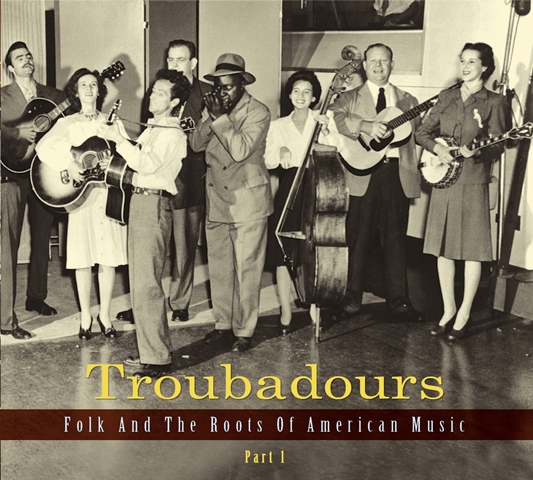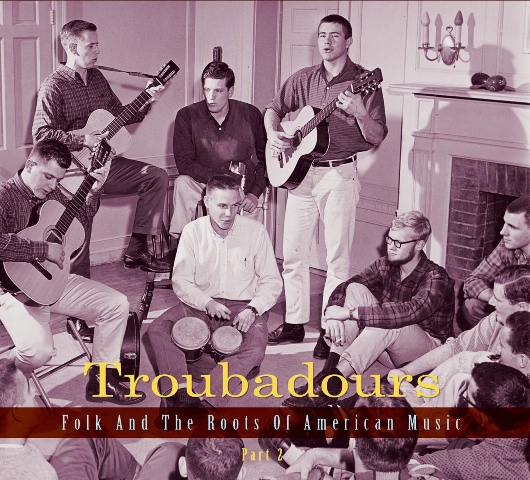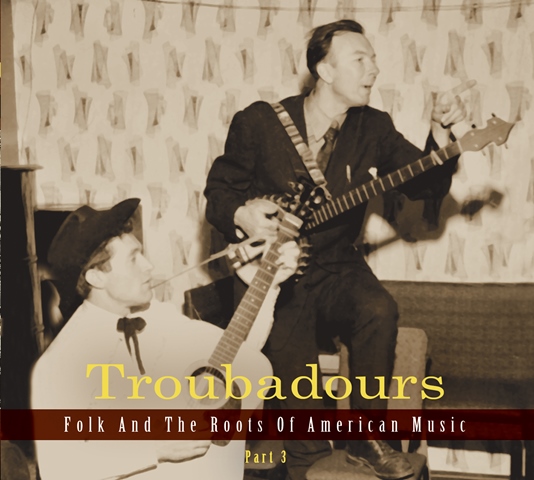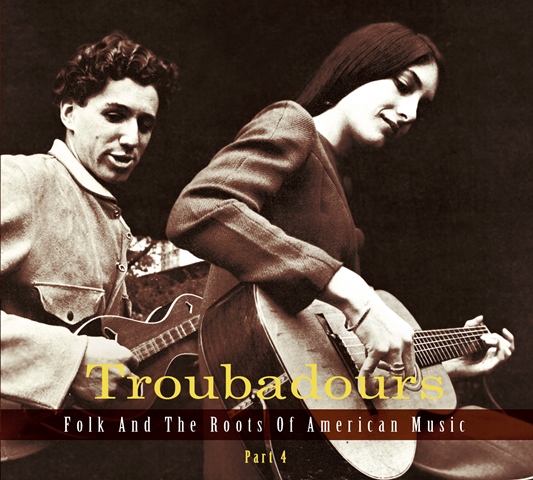Reissue CDs Weekly: Troubadours - Folk and the Roots of American Music | reviews, news & interviews
Reissue CDs Weekly: Troubadours - Folk and the Roots of American Music
Reissue CDs Weekly: Troubadours - Folk and the Roots of American Music
Mammoth musical encyclopaedia of a strain of music integral to American culture

 Various Artists: Troubadours - Folk and the Roots of American Music Part 1; Part 2; Part 3; Part 4
Various Artists: Troubadours - Folk and the Roots of American Music Part 1; Part 2; Part 3; Part 4
This is one of the most important reissues of the year. As the year ends, it may become the most important. Troubadours - Folk and the Roots of American Music is a set of four, individual three-CD sets charting the evolution of the American folk-based singer-songwriter style from its roots and influences to when it became a default mode of expression in the mid-Sixties and later.
All-encompassing are words underselling Troubadours. Everything which should be, and everyone who needs to be, is here. This aural encyclopaedia has a scope never attempted before. The packaging is fantastic. Each three-CD set is in a triple fold-out digipack and includes a 110- to 150-page book with definitive, literate essays on each artist and contextualising summaries for each group of selections. The music is also, always, fantastic with the contributor's most influential or definitive songs chosen.
 Overall, 288 tracks are heard. The total playing time is 15-and-a-quarter hours. The earliest performance is The Carter Family’s “Wildwood Flower”, recorded in 1928, and the – in general – cut-off point is 1974, the year of Harry Chapin’s “Cat’s in the Cradle” and John Denver’s “Back Home Again”.
Overall, 288 tracks are heard. The total playing time is 15-and-a-quarter hours. The earliest performance is The Carter Family’s “Wildwood Flower”, recorded in 1928, and the – in general – cut-off point is 1974, the year of Harry Chapin’s “Cat’s in the Cradle” and John Denver’s “Back Home Again”.
In tracing the path from the Twenties to the Seventies, the content is broken down under a series of headings – musical chapters effectively. Part 1 begins with The Influences (Goebel Reeves, The Carter Family, Lead Belly) and moves on to The Pioneers (Carl Sandberg, The Dixon Brothers, Earl Robinson) and The Lomax Folksingers (those brought to attention by or influenced by archivist Alan Lomax: Josh White, Burl Ives). The final Part 1 disc ends with The Folk Singers from the Fifties (The Gateway Singers, The Easy Riders, Vince Martin's Tarriers). Ths is a continuum where Bob Dylan was amongst the influenced, rather than the signifier he became codified as.
 Breaking this mammoth set into discrete sections is both logical and brave. Logical as there were identifiable waves and geography specific scenes. Brave as it’s always possible to quibble. Tim Buckley, for example, is included along with Rod McKuen, Richard & Mimi Farina and Gene Clark in the West Coast grouping. Buckley first made a mark in New York, but the bulk of his recordings were made in Los Angeles.
Breaking this mammoth set into discrete sections is both logical and brave. Logical as there were identifiable waves and geography specific scenes. Brave as it’s always possible to quibble. Tim Buckley, for example, is included along with Rod McKuen, Richard & Mimi Farina and Gene Clark in the West Coast grouping. Buckley first made a mark in New York, but the bulk of his recordings were made in Los Angeles.
Dylan appears on CD5 (the discs are numbered sequentially as if this were a single box set), the second disc of Part 2. Grouped with The Standard Bearers, his epochal sextet of songs (“Blowing in the Wind” and "Tambourine Man" included) precede six by Phil Ochs. The pair were sparring partners and fed off each other – the photo of a smiling, cat-got-the-cream Ochs sitting by a gravestone bearing the name Zimmerman in the booklet is both ironic and extremely funny.
 The names keep coming: Woody Guthrie, Pete Seeger, Merle Travis, Cisco Houston, Jean Ritchie, The Kingston Trio, The Limeliters, Dave Van Ronk, Judy Collins, Fred Neil, Joan Baez, Buffy St. Marie, Jack Elliot, The Lovin’ Spoonful, Melanie, The Byrds, Harry Nilsson, Kris Kristofferson, John Prine, Gordon Lightfoot. It seems, and almost is, endless. Curiously, Simon and Garfunkel are not included. Their “Homeward Bound”, despite being written by Simon in the UK, is arguably part of this canon. But their absence hardly makes this less definitive.
The names keep coming: Woody Guthrie, Pete Seeger, Merle Travis, Cisco Houston, Jean Ritchie, The Kingston Trio, The Limeliters, Dave Van Ronk, Judy Collins, Fred Neil, Joan Baez, Buffy St. Marie, Jack Elliot, The Lovin’ Spoonful, Melanie, The Byrds, Harry Nilsson, Kris Kristofferson, John Prine, Gordon Lightfoot. It seems, and almost is, endless. Curiously, Simon and Garfunkel are not included. Their “Homeward Bound”, despite being written by Simon in the UK, is arguably part of this canon. But their absence hardly makes this less definitive.
Endlessly dissecting and discussing Troubadours - Folk and the Roots of American Music is possible. But that would take almost the time required to listen to the set. It’s enough to know that as an overview of the development of a strain of music integral to American culture, this ground-breaking release is as important as Harry Smith’s 1952 Anthology of American Folk Music.
Overleaf: watch the trailer for Troubadours - Folk and the Roots of American Music
Watch the trailer for Troubadours - Folk and the Roots of American Music
Buy
Share this article
The future of Arts Journalism
You can stop theartsdesk.com closing!
We urgently need financing to survive. Our fundraising drive has thus far raised £33,000 but we need to reach £100,000 or we will be forced to close. Please contribute here: https://gofund.me/c3f6033d
And if you can forward this information to anyone who might assist, we’d be grateful.

Subscribe to theartsdesk.com
Thank you for continuing to read our work on theartsdesk.com. For unlimited access to every article in its entirety, including our archive of more than 15,000 pieces, we're asking for £5 per month or £40 per year. We feel it's a very good deal, and hope you do too.
To take a subscription now simply click here.
And if you're looking for that extra gift for a friend or family member, why not treat them to a theartsdesk.com gift subscription?
more New music
 Album: Mark Morton - Without the Pain
Second solo album from Lamb of God guitarist lays down hefty southern boogie
Album: Mark Morton - Without the Pain
Second solo album from Lamb of God guitarist lays down hefty southern boogie
 Manic Street Preachers, Barrowland, Glasgow review - elder statesmen deliver melody and sing-a-longs
The trio ran through new songs, obscure oldies and big hits in a career spanning set
Manic Street Preachers, Barrowland, Glasgow review - elder statesmen deliver melody and sing-a-longs
The trio ran through new songs, obscure oldies and big hits in a career spanning set
 Album: Rhiannon Giddens & Justin Robinson - What Did the Blackbird Say to the Crow
Finger-picking good
Album: Rhiannon Giddens & Justin Robinson - What Did the Blackbird Say to the Crow
Finger-picking good
 Music Reissues Weekly: Motor City Is Burning - A Michigan Anthology 1965-1972
Wide-ranging overview of the US state accommodating Detroit, the ‘rock city’
Music Reissues Weekly: Motor City Is Burning - A Michigan Anthology 1965-1972
Wide-ranging overview of the US state accommodating Detroit, the ‘rock city’
 theartsdesk on Vinyl: Record Store Day Special 2025
What Record Store Day exclusives are available this year?
theartsdesk on Vinyl: Record Store Day Special 2025
What Record Store Day exclusives are available this year?
 Album: Joe Lovano - Homage
Free-flowing spontaneity
Album: Joe Lovano - Homage
Free-flowing spontaneity
 Album: Bon Iver - SABLE ƒABLE
An album of exquisite wonder
Album: Bon Iver - SABLE ƒABLE
An album of exquisite wonder
 Primal Scream, O2 Academy, Birmingham review - from anthems of social justice to songs of heartbreak
Bobby Gillespie and Andrew Innes aren’t ready to join the heritage circuit yet
Primal Scream, O2 Academy, Birmingham review - from anthems of social justice to songs of heartbreak
Bobby Gillespie and Andrew Innes aren’t ready to join the heritage circuit yet
 theartsdesk on Vinyl 89: Wilco, Decius, Hot 8 Brass Band, Henge, Dub Syndicate, Motörhead and more
The last-standing and largest regular vinyl record reviews in the world
theartsdesk on Vinyl 89: Wilco, Decius, Hot 8 Brass Band, Henge, Dub Syndicate, Motörhead and more
The last-standing and largest regular vinyl record reviews in the world
 Album: Black Country, New Road - Forever Howlong
A left turn that trades chaos for charm, with mixed results
Album: Black Country, New Road - Forever Howlong
A left turn that trades chaos for charm, with mixed results
 Tallinn Music Week 2025 review - Estonia’s capital accommodates all flavours of music
The festival where everything appears on an equal footing
Tallinn Music Week 2025 review - Estonia’s capital accommodates all flavours of music
The festival where everything appears on an equal footing
 An Evening with Joan Armatrading, Cadogan Hall review - thoughtful and engaging conversation
From rock'n'roll to Open University, the singer on life and work
An Evening with Joan Armatrading, Cadogan Hall review - thoughtful and engaging conversation
From rock'n'roll to Open University, the singer on life and work

Add comment